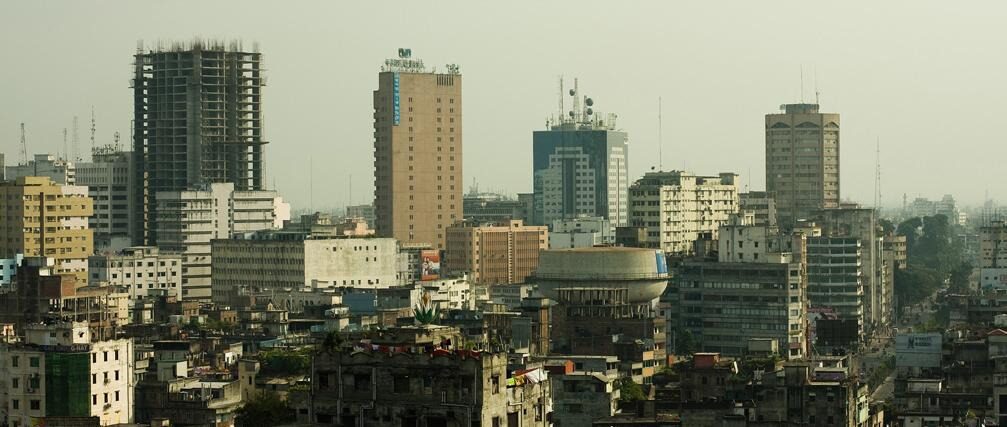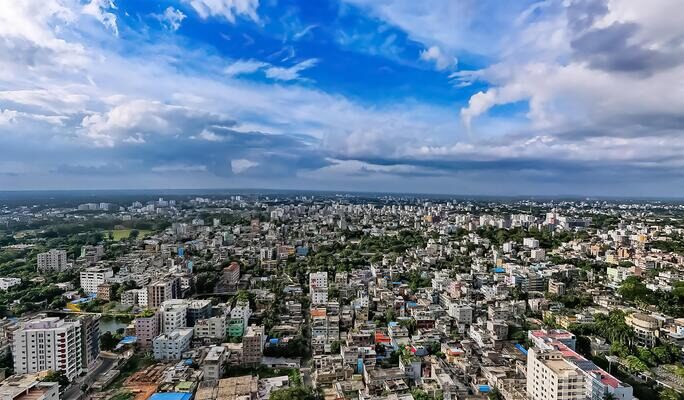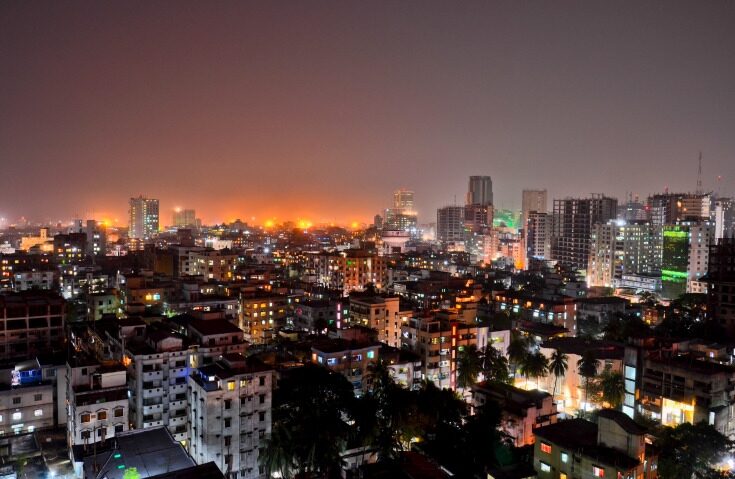Dhaka is the capital of Bangladesh and one of the world’s most densely populated metropolises.
1. City Overview
- Population: Approximately 10.2 million in the city proper (NCT Dhaka) as of 2024. The Metropolitan (Dhaka Metro Area) population is over 23.9 million, projected to reach 24.65 million by 2025, with an annual growth rate of 3%. It is one of the most densely populated cities in the world, with about 34,000–47,400 people per km².
- Area: The city proper covers approximately 300 km². The metropolitan area is much more extensive, expanding rapidly with a super high-density urban structure and many separated administrative zones.
- Languages: The main language is Bengali (Bangla), with English, Urdu, and various other languages also spoken. English serves as an auxiliary language for administration and education.
- Religion: Predominantly Islam (primarily Sunni), accounting for about 90%, followed by Hinduism (about 8%), Christianity, and Buddhism.
- Economy Size: Nominal GDP is approximately 85.5 billion USD, and PPP is 285.1 billion USD. It accounts for about 40% of Bangladesh’s GDP.
- Human Development Index (HDI): 0.756 as of 2022.
- Climate: Tropical monsoon climate with an annual average temperature of 25°C and concentrated rainfall of 1,854 mm/year during the wet season.

2. History
- Ancient to Mughal Period: Settled since ancient times, Dhaka developed into “Jahangirnagar,” a provincial capital of the Mughal Empire in the early 17th century (1608–39, 1660–1704). It prospered as a center for Bangladeshi muslin textile production (muslin and Jamdani).
- Colonial Period: From the late 19th to early 20th century, it grew as a port and industrial city under British colonial rule.
- Post-Independence: Incorporated into East Pakistan in 1947, it remained the capital after Bangladesh’s independence in 1971. Rapid urbanization and megacity growth began after 1975.
- Rapid Growth & Smart City Initiatives (21st Century): The Metro Rail and BRT began operations in 2022. Urban expansion has led to increased NGO-led infrastructure and urban management policies.
3. Geography
- Location and Topography: Situated in the central region of the Ganges Delta, near the Bay of Bengal. It is a river confluence zone with major rivers including Buriganga, Turag, Dhaleshwari, and Shitalakshya.
- Urban Structure:
- Old Dhaka: Densely packed with Mughal-era relics.
- New Dhaka and Northern/Eastern New Downtown: Administrative and commercial centers, including Ramna.
- Hatirjheel and Dhanmondi are examples of emerging satellite living areas and rapidly expanding suburban regions.
- Dense Pattern: Characterized by a mix of residential and industrial areas, with numerous slum regions.

4. Culture
- Language and Religious Culture: Bengali is central, with English, Urdu, and regional dialects intermingled. Islamic and Hindu events coexist, with active religious festivals such as Eid al-Fitr and Diwali.
- Cultural Heritage and Arts: Often called the ‘City of Mosques’ due to its rich Islamic architectural heritage. Historic sites include Lalbagh Fort (1678), Ahsan Manzil (1872), Binat Bibi Mosque (1457), and Dhakeshwari Temple. Dhaka University, national museums, art galleries, and modern performance venues are also present.
- Festivals and Arts: Festivals include Pohela Boishakh (Bengali New Year) and Independence Day. Jamdani saree production is a notable craft, and it is a cultural city centered around universities and literary circles.
- Urban Experience: Features like rickshaws (bicycle taxis) and bustling markets (similar to Chandni Chowk) characterize the city.
5. Environment
- Natural Environment & Green Spaces: The city has large waterway networks and multi-purpose lakes such as Hatirjheel and Dhanmondi Lake in its surroundings.
- Environmental Risks & Responses: Ultra-dense urbanization leads to traffic congestion, smog, river pollution, and recurring floods. Overcrowding, illegal construction, water and air pollution, flood risks, and an increase in slums are serious ongoing issues, particularly affecting poverty-stricken housing and sanitation. Improvement efforts include urban regeneration programs, expansion of Metro and BRT infrastructure, and NGO-led regeneration projects alongside government-led climate and environmental improvement projects, including improved drainage systems.
6. Economy
- Economic Scale: Nominal GDP of approximately $21.3 billion USD, and PPP of $31.6 billion USD (2022). It accounts for about 40% of Bangladesh’s domestic product.
- Industrial Characteristics: Based on a diversified manufacturing sector including apparel/textiles, pharmaceuticals, electronics, shipbuilding, and liquor.
- Financial Hub: Home to the Bangladesh Bank and Dhaka Stock Exchange, with expanding routes for multinational corporations, SMEs, and startups.
- Industrial Structure: Many in household and informal labor, with apparel manufacturing (sewing industry) being central, employing about 800,000 people. Major commercial districts include Motijheel and Gulshan, and large shopping malls like Bashundhara City. It features an export-oriented manufacturing base, a financial sector (Dhaka Stock Exchange), and an active domestic consumer market.
- GDP & Employment: The metropolitan GDP was approximately $126 billion USD in 2020, with an average annual growth rate of 6%. Poverty and unemployment remain significant challenges.

7. Key Locations
- Historical and Architectural Heritage:
- Historical and Cultural Center: Lalbagh Fort, Ahsan Manzil, Binat Bibi Mosque, Dhakeshwari Temple, Chawk Bazaar, Ramna Green.
- Lalbagh Fort: 17th-century Mughal architecture.
- Hatirjheel: An eco-friendly waterway park for urban regeneration.
- Dhanmondi Lake: An example of residential development and green space preservation from the 1950s.
- Cultural and Commercial Hubs:
- Jamuna Future Park and Bashundhara City Mall: South Asia’s largest shopping mall complexes.
- Gulshan and Banani: Diplomatic, high-end residential, and office districts.
- Transportation Infrastructure:
- Hazrat Shahjalal Airport.
- Dhaka Metro Rail and BRT system have been introduced.
- Dhaka River Port: The Buriganga port has been in operation since the 17th century.
8. Conclusion
Dhaka is a city navigating the dual challenges of ultra-dense urbanization and rapid maturation.
- Strengths: Rich Mughal cultural heritage, rapidly expanding economy, global apparel export hub, existing urban regeneration initiatives, a manufacturing and financial industry center, and the economic heart of Bangladesh.
- Challenges: Environmental pollution, limited transport and housing infrastructure, frequent flooding, and persistent complex urban issues like informal labor.
- Future Strategy: Focus on expanding eco-friendly waterfront spaces (e.g., Hatirjheel), strengthening sewage/drainage/green space systems, enhancing public transportation (Metro, BRT), increasing cooperation between NGOs and the government for poverty and housing improvement, and simultaneously preserving historical districts while improving living conditions. It also aims to ensure sustainability through smart city development.
